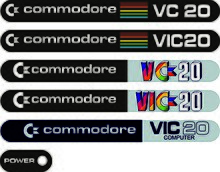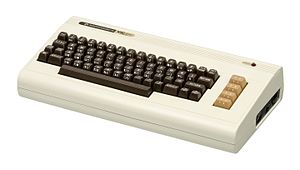Commodore Vic 20
 |
|
 |
|
| Developer | Jack Tramiel |
|---|---|
| Manufacturer | commodore |
| Product family | micro computers |
| Type | Home computer |
| Release date | 1980 (VIC-1001) / 1981 |
| Retail availability | 5 years |
| Introductory price | US$299.95 (equivalent to $744.39 in 2016) |
| Discontinued | January 1985 |
| Operating system |
Commodore KERNAL/ Commodore BASIC 2.0 |
| CPU | MOS Technology 6502 @ 1.108404 MHz (PAL) @ 1.02 MHz (NTSC) |
| Memory | 20 KB ROM + 5 KB RAM (expandable to 32 KB), 3.5 KB for BASIC (expandable to 27.5 KB) |
| Storage | Cassette tapes and floppy disks |
| Display | commodore 1701 |
| Graphics | VIC 176 x 184 3-bpp |
| Sound | 3 × square, 1 × noise, mono. |
| Input | tape and floppy disks and cartridge |
| Predecessor | Commodore PET |
| Successor | Commodore 64 |
The VIC-20 (in Germany: VC-20; In Japan: VIC-1001) is an 8-bit home computer that was sold by Commodore Business Machines. The VIC-20 was announced in 1980, roughly three years after Commodore's first personal computer, the PET. The VIC-20 was the first computer of any description to sell one million units.
The VIC-20 was intended to be more economical than the PET computer. It was equipped with 5 KB of static RAM and used the same MOS 6502 CPU as the PET. The VIC-20's video chip, the MOS Technology VIC, was a general-purpose color video chip designed by Al Charpentier in 1977 and intended for use in inexpensive display terminals and game consoles, but Commodore could not find a market for the chip.
As the Apple II gained momentum with the advent of VisiCalc in 1979, Jack Tramiel wanted a product that would compete in the same segment, to be presented at the January 1980 CES. For this reason Chuck Peddle and Bill Seiler started to design a computer named TOI (The Other Intellect). The TOI computer failed to materialize, mostly because it required an 80-column character display which in turn required the MOS Technology 6564 chip. However, the chip could not be used in the TOI since it required very expensive static RAM to operate fast enough.
In the meantime, freshman engineer Robert Yannes at MOS Technology (then a part of Commodore) had designed a computer in his home dubbed the MicroPET and finished a prototype with some help from Al Charpentier and Charles Winterble. With the TOI unfinished, when Jack Tramiel was confronted with the MicroPET prototype, he immediately said he wanted it to be finished and ordered it to be mass-produced following a limited demonstration at the CES.
...
Wikipedia
